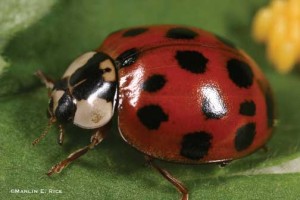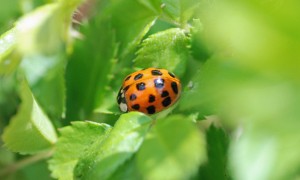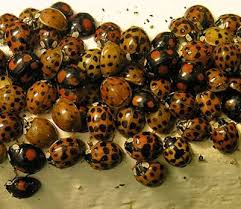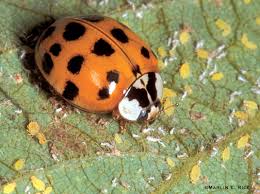 Harmonia axyridis commonly known as ‘Multicolored Asian lady beetles’ is a large coccinellid beetle. Its color ranges from yellow-orange to black, and the number of spots between none and 22. It is native to eastern Asia but has been artificially introduced to North America and Europe to control aphids and scale insects. It is now common, well known, and spreading in those regions, and has also established in South Africa and widely across South America.
Harmonia axyridis commonly known as ‘Multicolored Asian lady beetles’ is a large coccinellid beetle. Its color ranges from yellow-orange to black, and the number of spots between none and 22. It is native to eastern Asia but has been artificially introduced to North America and Europe to control aphids and scale insects. It is now common, well known, and spreading in those regions, and has also established in South Africa and widely across South America.
Multicolored Asian lady beetles are about 7 mm long. As the name indicates, they occur in a wide spectrum of colors ranging from yellow to orange to red and have a varying number of spots. The variability of appearance in the adults can mislead people to think they are different species. A characteristic that assists in their identification is an “M” shaped marked located behind the head.There are about 5,000 species of ladybug beetles worldwide, so depending on the species and habitat, there is a large variation in this insect’s lifecycle. For example, some lady beetles are predators, while others are plant feeders.
 The greatest damage caused by the multicolored Asian lady beetle is the discomfort they give to homeowners. It is not uncommon for tens of thousands of beetles to congregate in attics, ceilings, and wall voids, and due to the warmth of the walls, will move around inside these voids and exit into the living areas of the home. In addition to beetles biting (which they do), they exude a foul-smelling, yellow defensive chemical which will sometimes cause spotting on walls and other surfaces. They are also known for the annoying habit of accumulating on the sides of buildings and wandering indoors during the fall. Asian lady beetles are a beneficial biological control in trees during the summer, and in fields and gardens during the fall, but can be a severe household nuisance during late fall and winter. Wooded residential and industrial areas are especially prone to problems.
The greatest damage caused by the multicolored Asian lady beetle is the discomfort they give to homeowners. It is not uncommon for tens of thousands of beetles to congregate in attics, ceilings, and wall voids, and due to the warmth of the walls, will move around inside these voids and exit into the living areas of the home. In addition to beetles biting (which they do), they exude a foul-smelling, yellow defensive chemical which will sometimes cause spotting on walls and other surfaces. They are also known for the annoying habit of accumulating on the sides of buildings and wandering indoors during the fall. Asian lady beetles are a beneficial biological control in trees during the summer, and in fields and gardens during the fall, but can be a severe household nuisance during late fall and winter. Wooded residential and industrial areas are especially prone to problems.
In Asia, multicolored Asian lady beetles feed primarily on aphids found in trees. In the U.S., they feed on aphids not only in trees but also in agricultural crops and gardens. In fact, the multicolored Asian lady beetle is an important predator of soybean aphids, a serious pest of soybeans in Minnesota and other Midwest states.
 In their native Asian habitat, these insects fly to cliffs and rock outcroppings each fall where they overwinter in large numbers. In the absence of such areas in the U.S., the beetles seek out sunny sides of tall or prominent buildings during fall. Lady beetles are particularly attracted to buildings that have contrasting dark and light areas. Because the beetles feed on aphids in trees, buildings adjacent to wooded areas are more likely to encounter large numbers of multicolored Asian lady beetles than buildings in open areas.
In their native Asian habitat, these insects fly to cliffs and rock outcroppings each fall where they overwinter in large numbers. In the absence of such areas in the U.S., the beetles seek out sunny sides of tall or prominent buildings during fall. Lady beetles are particularly attracted to buildings that have contrasting dark and light areas. Because the beetles feed on aphids in trees, buildings adjacent to wooded areas are more likely to encounter large numbers of multicolored Asian lady beetles than buildings in open areas.
Large numbers of lady beetles generally begin to fly to buildings on the second day of temperatures above 65 o F that follow freezing or near freezing temperatures. Such conditions usually occur in Minnesota between late September and late October.
Once lady beetles reach buildings, they crawl into cracks and gaps around windows, doors, roof lines, and other openings. Some continue to move inside the structure until they reach the living areas of homes where they soon die. Others will find suitable overwintering inside wall voids, attics, and other areas, sometimes forming large living masses of insects.
Let us look at the following recent news article regarding infestation caused by lady beetle.
Asian lady beetle infestation is upon northern Minnesota
By John Myers on Oct 12, 2015, at 6:00 p.m.
They are out there all summer, living in the woods and fields, and now they want a snug place to spend the winter.
Your house, cabin, camper or deer shack will do just fine, thank you.
Orange Asian lady beetles, the little bugs who have replaced ladybugs across much of the landscape, are making their annual trek from the outdoors to indoors, and the infestation seems worse than ever to many Northlanders.
“We’ve had them before, but never this bad. It’s been pretty nasty,” said Dan Woodhull of South Range, who had hundreds of the beetles in his house in recent days.
Reports of beetle outbreaks are coming in from across the region.
“It does seem particularly bad this year. We’ll have to wait and see if this is just an early rush or if there really are this many more of them,” said Larry Weber, a Duluth-area naturalist. “I left my vehicle sitting out overnight and I had a bunch of them that tried to get into it, all around the door seals.”
Asian lady beetles are much the same that field mice, Weber noted, always around but mostly unnoticed until they try to get indoors this time of year.
Experts say the beetles are pushed by diminishing daylight hours to seek winter cover. But they also swarm and fly most often on warm, sunny fall days following the first cold snap — which may be why so many people reported infestations over this past weekend.
“I noticed them for the first time over the weekend. I’m getting a lot of calls on them,” Minnesota Department of Natural Resources entomologist Val Cervenka said Monday.
Amanda Glowacki at Guardian Pest Control in Duluth said many people are calling to say they are grossed out by such large numbers of the orange bugs.
“We’ve been getting a lot of calls on them this year. That’s what nearly all of our calls have been for the last couple of weeks,” she said.
Marty Johnson, a technician at Guardian, said he offers an exterior “ground to eaves” chemical treatment for homes that often also reduces beetle numbers inside the house, too. It costs $200. He also offers interior treatments.
“I had them all over my house this weekend, too,” he said.
Experts say the best way to get rid of Asian lady beetles is to vacuum them up, but then empty the vacuum or it may start to smell bad. To keep them out of your house, seal up even tiny cracks, around doors and windows, where cable, pipes or wires enter homes, and under fascia, soffits and eaves.
“But they will still find some way to get in, it seems,” Weber said.
Woodhull said he turned on his home’s air conditioning so the beetles huddled together, and then sucked them up with a vacuum.
The first Asian lady beetle infestation in the U.S. was reported in Louisiana in 1988. Since then the beetle has expanded across the U.S. and parts of Canada. There’s still debate if the outbreak was caused by beetles that were intentionally released to see if they might help control plant pests, or if the beetles spurring the outbreak hitchhiked on a freighter that docked in New Orleans. The first big U.S infestations occurred in the 1990s. The first major Northland outbreaks were in the early 2000s, Weber noted.
Native red ladybugs are considered beneficial because they live on flowers and plants and eat other pests and don’t swarm into buildings. But the orange Harmonia axyridis — native to China, Korea, Russia and Japan — can swarm in large numbers, crawl around on windows, walls and ceilings, and sometimes emit a noxious odor and yellowish staining fluid before dying, according to University of Minnesota Extension entomologists. The bug experts say Asian lady beetles are attracted to illuminated surfaces. They tend to congregate on the sunnier, southwest sides of buildings illuminated by afternoon sun.
They don’t eat wood or cause damage, experts say, and don’t spread disease. But some people say the orange beetles can bite.
Weber, however, says it’s more of a pinch. “I don’t think they can really break the skin, like a true bite, but they might annoy some people by pinching their skin.”
Others report incidents of asthma or allergy outbreaks after an Asian lady beetle infestation.
Asian lady beetles generally lay eggs outdoors under leaves, but may lay eggs inside, too. The average time from egg to adult is about one month and there are multiple generations per year. Individual beetles can live up to three years. They appear to have few if any natural enemies in North America.
Some folks who noticed them in and around their place this fall may see them again when temperatures warm in spring. Awakening beetles may emerge from behind baseboards, walls, attics and suspended ceilings. Because the beetles are attracted to light, they often are seen around windows and light fixtures.
 Multicolored Asian lady beetles can be beneficial insects. They do a great job of controlling aphids that can damage many types of plants – this is called “biocontrol” – and they reduce the need for harmful pesticides. Despite this benefit, people are bothered by the beetles swarming outside their homes or flying around inside the house. Thus one needs to b very careful in taking measures against these pests. We need a solution that helps protect our shrubs and plants from damage, while at the same time does not harm the environment or these beneficial insects in any way. So, how do we fight this pest?
Multicolored Asian lady beetles can be beneficial insects. They do a great job of controlling aphids that can damage many types of plants – this is called “biocontrol” – and they reduce the need for harmful pesticides. Despite this benefit, people are bothered by the beetles swarming outside their homes or flying around inside the house. Thus one needs to b very careful in taking measures against these pests. We need a solution that helps protect our shrubs and plants from damage, while at the same time does not harm the environment or these beneficial insects in any way. So, how do we fight this pest?
C Tech Corporation can offer a solution to overcome this problem. Our product Combirepel™ is an extremely low toxicity and extremely low hazard and eco-friendly rodent aversive. Combirepel™ is available in the form of solid masterbatches, liquid concentrate and in lacquer form. The product is compliant with RoHS, RoHS2, and REACH and is FIFRA exempted. This product acts through a series of highly developed intricate mechanism ensuring that rodents are kept away from the target application.
The fencing and tree guards can be coated withCombirepel™ to protect the trees, shrubs etc. from the damage caused by the grey squirrels. The product can also be incorporated into agricultural films, greenhouse films, plastic mulches used on a large scale in the agriculture as well as horticulture sector in order to avoid damages caused by these squirrels to fruits and vegetables. Also, the products can be directly incorporated in the polymer matrix during processing of pipes and tubing. Combirepel™ does not leach out, thus there is no soil pollution. Groundwater reserves are also not polluted. Also the non-target beneficial species like earthworms, bees etc are not affected.
The product is compliant with ROHS, ROHS2, ISO, REACH, APVMA, NEA, EU-BPR, and FIFRA exempted.
Contact us at technical.marketing@ctechcorporation.com if you’re facing problems with rodents and get best remedies to combat the pest menace.
Also, visit our websites:
http://www.ctechcorporation.com/
http://www.rodrepel.com/
http://www.termirepel.com/
http://www.combirepel.com/
Follow our Facebook pages at:
1] https://www.facebook.com/Combirepel-411710912249274/
2] https://www.facebook.com/Termirepel-104225413091251/
3] https://www.facebook.com/Rodrepel-120734974768048/
Follow us on our Twitter pages at:
1] https://twitter.com/rodrepel
2] https://twitter.com/termirepel
3] https://twitter.com/combirepel

